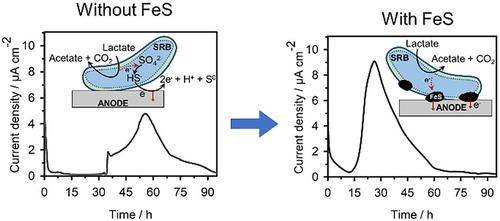当前位置:
X-MOL 学术
›
ChemElectroChem
›
论文详情
Our official English website, www.x-mol.net, welcomes your
feedback! (Note: you will need to create a separate account there.)
Biosynthesized Iron Sulfide Nanocluster Enhanced Anodic Current Generation by Sulfate Reducing Bacteria in Microbial Fuel Cells
ChemElectroChem ( IF 3.5 ) Pub Date : 2018-10-15 , DOI: 10.1002/celc.201801086 Muralidharan Murugan 1, 2 , Waheed Miran 3, 4 , Takuya Masuda 1 , Dae S. Lee 3 , Akihiro Okamoto 4
ChemElectroChem ( IF 3.5 ) Pub Date : 2018-10-15 , DOI: 10.1002/celc.201801086 Muralidharan Murugan 1, 2 , Waheed Miran 3, 4 , Takuya Masuda 1 , Dae S. Lee 3 , Akihiro Okamoto 4
Affiliation

|
The anodic oxidation of sulfide metabolically generated from sulfate is considered to be the primary mechanism of sulfate reducing bacteria (SRB) to contribute to the current generation in Microbial Fuel Cells (MFCs). However, the other redox active metabolic by‐product of conductive iron sulfide (FeS) has been seldomly studied in the context of anodic current generation. Here, we demonstrate that the biomineralized FeS increased the anodic current production in Desulfovibrio vulgaris Hildenborough, compared with that mediated by diffusive sulfate. Chronoamperometry on indium tin‐doped oxide electrodes (ITO) poised at +0.4 V (vs SHE) in the presence of lactate and sulfate showed that the presence of ferrous ion caused twice more anodic current than that in the absence of the iron. Linear Sweep Voltammetry (LSV), Scanning Electron Microscopy (SEM) and X‐ray Photoelectron Spectroscopy confirmed that the aggregation formation of cells with FeS and FeS2 particles on the surface of the ITO electrode. These iron sulfur precipitates were more oxidized on the anode surfaces once lactate was depleted as electron source. The presented data suggests that biosynthesized FeS mediates the electron transport from D. vulgaris Hildenborough to the electrode surface. Given microbial capability of FeS biosynthesis is general among SRB, the FeS‐mediated mechanism may dominate anodic current generation of SRB in MFCs.
中文翻译:

通过硫酸盐还原细菌在微生物燃料电池中生物合成的硫化铁纳米簇增强阳极电流的产生
从硫酸盐代谢产生的硫化物的阳极氧化被认为是硫酸盐还原细菌(SRB)促成微生物燃料电池(MFCs)产生电流的主要机制。但是,很少在阳极电流产生的背景下研究导电性硫化铁(FeS)的其他氧化还原活性代谢副产物。在这里,我们证明了生物矿化的FeS增加了寻常脱硫弧菌中的阳极电流产生希尔登堡,与扩散硫酸盐介导的相比。在乳酸和硫酸盐存在下,铟锡掺杂氧化物电极(ITO)保持在+0.4 V(vs SHE)上的计时电流法表明,亚铁离子的存在比不存在铁的阳极产生的阳极电流多两倍。线性扫描伏安法(LSV),扫描电子显微镜(SEM)和X射线光电子能谱证实了在ITO电极表面上具有FeS和FeS 2颗粒的细胞的聚集形成。一旦乳酸作为电子源被耗尽,这些铁硫沉淀物在阳极表面上被更多地氧化。提出的数据表明,生物合成的FeS介导了来自寻常小球藻的电子传输。希尔登伯勒到电极表面。鉴于SRB中FeS生物合成的微生物能力是普遍的,因此FeS介导的机制可能主导MFC中SRB的阳极电流产生。
更新日期:2018-10-15
中文翻译:

通过硫酸盐还原细菌在微生物燃料电池中生物合成的硫化铁纳米簇增强阳极电流的产生
从硫酸盐代谢产生的硫化物的阳极氧化被认为是硫酸盐还原细菌(SRB)促成微生物燃料电池(MFCs)产生电流的主要机制。但是,很少在阳极电流产生的背景下研究导电性硫化铁(FeS)的其他氧化还原活性代谢副产物。在这里,我们证明了生物矿化的FeS增加了寻常脱硫弧菌中的阳极电流产生希尔登堡,与扩散硫酸盐介导的相比。在乳酸和硫酸盐存在下,铟锡掺杂氧化物电极(ITO)保持在+0.4 V(vs SHE)上的计时电流法表明,亚铁离子的存在比不存在铁的阳极产生的阳极电流多两倍。线性扫描伏安法(LSV),扫描电子显微镜(SEM)和X射线光电子能谱证实了在ITO电极表面上具有FeS和FeS 2颗粒的细胞的聚集形成。一旦乳酸作为电子源被耗尽,这些铁硫沉淀物在阳极表面上被更多地氧化。提出的数据表明,生物合成的FeS介导了来自寻常小球藻的电子传输。希尔登伯勒到电极表面。鉴于SRB中FeS生物合成的微生物能力是普遍的,因此FeS介导的机制可能主导MFC中SRB的阳极电流产生。











































 京公网安备 11010802027423号
京公网安备 11010802027423号